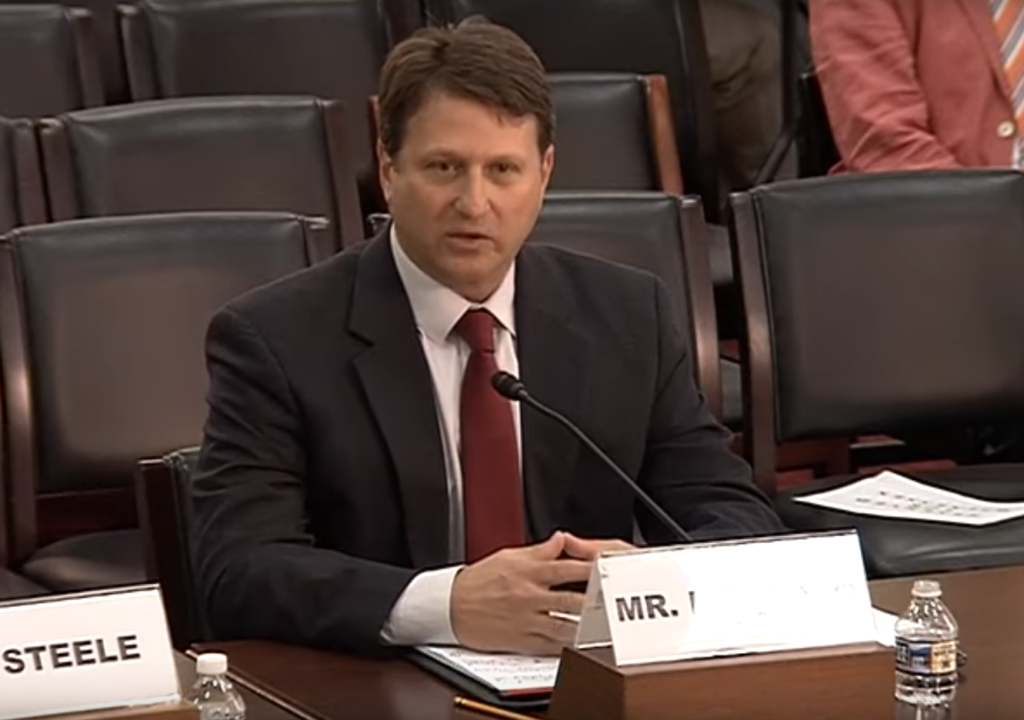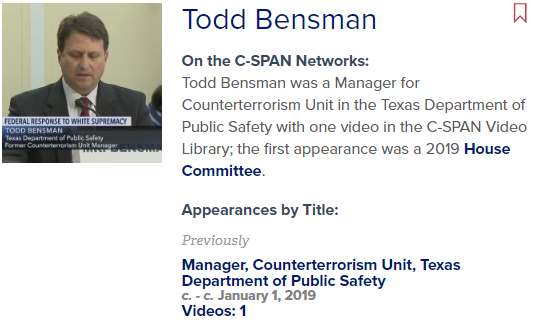I testified before the House Oversight and Reform Committee about my experience combating domestic extremism while working for the Texas Department of Public Safety. The testimony took place Tuesday, June 4, 2019 in the Rayburn House Office Building, Washington, D.C.


The topic of testimony for two panels (mine was the second) was “White Supremacy, Adequacy of the Federal Response.”
PURPOSE OF HEARING:
- The hearing will examine the efforts of the Federal Bureau of Investigation (FBI) and the Department of Homeland Security (DHS) to combat white supremacist extremist violence, including their budgets and allocations of personnel, data collection practices, and strategic plans.
- Under the Trump Administration, DHS appears to have significantly reduced resources and infrastructure that would address the increasing threat of white supremacist extremism. Reportedly, DHS recently disbanded a group of analysts focused on domestic terrorism in the Office of Intelligence and Analysis, reducing the number of analytic reports on white supremacists.
- Last month, the Subcommittee held its first hearing on this issue to examine the rising threat of white supremacist violent extremism in the United States and the impact on communities frequently targeted by white supremacists. Witnesses included Susan Bro, the mother of Heather Heyer who was killed in Charlottesville, and former DHS official George Selim.
Video of the full hearing can be found here, starting at Minute 3:24:00
SEE THE FULL WRITTEN TESTIMONY, as entered into the Congressional Record, HERE
My five-minute opening statement is below:
Chairman Raskin and Subcommittee Members, thank you for inviting me to discuss the important issue of countering hate-based domestic extremism in all of its forms, which presents a steady threat to public safety.
I am here to share insights from my decade-long work countering domestic extremism with the FBI and DHS through August 2018 with the Texas Department of Public Safety’s Intelligence and Counterterrorism Division. I helped build and manage a counterterrorism unit of intelligence analysts for one of the country’s most muscular fusion centers, the Joint Information Crime Center in Austin. With security clearances, we worked under one roof with the FBI, DHS Intelligence and Analysis officers and many other federal agencies.
Texas certainly has its share of racially motivated extremists, and we worked hard to learn their criminal intentions.

Neither we nor the FBI ever dismissed the domestic extremist threat or violent white supremacists, as some suggest, but faced them at every turn during my service from 2009-2018.
I personally saw to it that some of my analysts were always dedicated to this threat problem. We worked hand-in-glove with the FBI’s five Joint Terrorism Task Forces in Texas, each of which maintained its own domestic terrorism squad. For an idea of how hand in glove, Texas DPS investigators were assigned to all five JTTFs, usually to the domestic terrorism squads. Information sharing was strong both ways in our system.
What I can tell you from my experience is that:
Our collaborative arrangements remained in place after the 2016 election. At the line level, we created intelligence, passed information to the FBI on the e-Guardian system or in person, and filled their requests for their case needs. Good things happened as a result.
For a number of years after 2010, DHS Intelligence & Analysis was not as helpful due to an order under Secretary Napolitano for the domestic threats group to stand down research and analysis. This was due to controversy over a leaked 2009 paper that returning military veterans might join extremist groups. In recent years, DHS I&A did begin to provide value.
The number of racially motivated criminal events is now higher than what we were used to. A pivot is necessary to reverse the trend. But any effort must account for the fact that not all dangerous domestic extremists are motivated by racist or religious animus. In Texas, anti-government extremists not animated by racism threatens public safety too, as evidenced by black nationalist extremists who have murdered and wounded 25 police officers since 2016, including five in one horrific Dallas ambush.
It would be a mistake not to recognize this diversity. We certainly worked on cases involving racial motivations, like:
- The Atomwaffen Division (Neo-Nazis), which thinks violence will ignite a race war to establish national socialism in the United States. Some have been implicated in murders, building a dirty bomb, and wanting to destroy infrastructure. Some of its national leaders are based in Texas.
But we worked on others not squarely in the white supremacist rubric.
- Sovereign citizen movement, which features anti-government, anti-tax extremists who mostly reject government authority over them.
- Anti-government militias. Texas residents have been linked with anti-federalists who carried out the 2014 Bundy Ranch standoff in Nevada and the 2016 Malheur National Wildlife Refuge standoff in Oregon.
- Anarchist extremists (Antifa movement) From November 2016 through the spring of 2017, masked anarchist extremists continually assaulted DPS troopers and peaceful demonstrators at the Texas State Capitol, harassed businesses in gentrifying neighborhoods, trained in live-fire military assault tactics, are on terror watch lists, and some currently fight with communist Kurdish groups in Iraq.
As the FBI pivots to meet an up-cycling domestic extremism, it should be remembered that a national fusion center infrastructure, with well-oiled collaborative practices are in place as a result of 9/11. I recommend that the homeland security enterprise:
1. Mobilize the nation’s 78 fusion centers to focus them on increased support to FBI JTTFs on this problem set.
2. Conduct a national risk assessment of bias-motivated criminality to build knowledge of the problem set.
3. Require police agencies to report bias crime to the FBI’s Unified Crime Report system. Currently, voluntary reporting is not reliable enough to do much of anything.
4. Require military services to collect and share disciplinary case information and suspicious behaviors as potential early warning, since service is a common circumstance among extremists.
